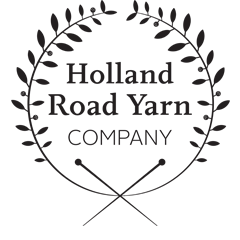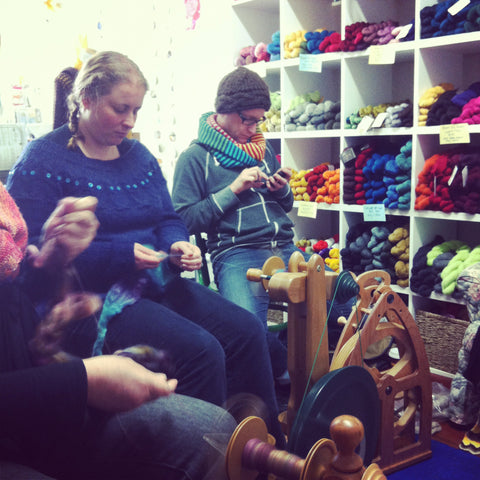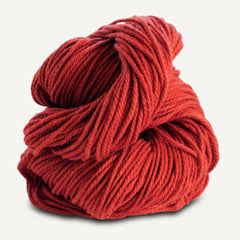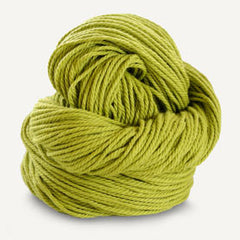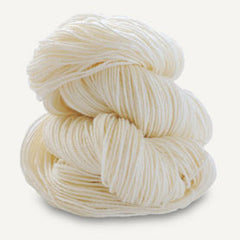HRYC
Super Simple Sock Pattern
The pdf pattern is now available.
After having a surprisingly tricky time finding a basic sock pattern for new sock knitters, we’ve written up our own. Knit from the cuff down, with no fussy details, this is a great sock for beginners and experienced sock knitters alike. The sample in the photos was striped – we used 2 skeins of Knitsch Sock ‘Caboose’ and one of ‘Plain & Simple’. Caboose was used for the cuff, heel and toe, and striped every 2 rows in the body of the sock with Plain & Simple. The pattern uses a short row heel – so don’t fret when it comes to the heel turn and you aren’t knitting across all of the stitches. By the end of this pattern section all stitches will be taken care of. You can find a pdf of the pattern and extra patterns notes on Ravelry.
Yarn: 2 skeins of Knitsch Sock or 100g of sock yarn
Needles: 2.50mm 80cm fixed circular, or 2.50mm double pointed needles
Sizes: Small (medium, large, X-large)
Gauge: 30 sts x 44 rows = 10cm
Abbreviations:
CO - cast on
K – knit
p – purl
ssk – slip, slip, knit
k2tog – knit two stitches together
p2tog – purl two stitches together
sl – slip the stitch from the left hand needle to the right needle without knitting
Pattern:
CO 60 (64, 68, 72) stitches Set up row: k2, p2, repeat until end next row: k2, p2, repeat until end. Join in the round, being careful not to twist. Place a marker to mark the beginning of the round. Split the number or stitches evenly across 2 needles (the magic loop using the circular needle) or 4 needles (if using double pointed needles).
Next row: k2, p2, repeat until end repeat rib pattern until cuff measures 2.5cm
Next row: knit Work in stocking stitch until leg measures approx 17cm or is desired length.
Heel flap: This section is worked flat over 30 (32, 34, 36) stiches. The other half of the stitches are held on the cable of your circular needle or on two dpns and are not knit at all until the heel section is completed. You will be turning your work as this part is knit flat rather than in the round.
Next row starting from marker: *sl1, k1, repeat from * 14 (15, 16, 17) more times 30 (32, 34, 36) stitches have been worked
Next row: turn work, *sl1, p to end
Next row: sl1, k2, *sl1, k1, repeat from * to end
Next row: sl1, p to end
Repeat these four rows 6 (7, 8, 9) more times, or until heel flap is length required. End on a purl row.
Heel turn: The heel turn is the bit that gets most people unstuck. As long as you follow the instructions word for word, and don’t worry about the stitches you aren’t knitting, it’ll make sense in the end.
Row 1: (right side of work) sl1, k16 (18, 18, 20), ssk, k1, turn work row 2: (wrong side of work) sl1, p5 (7, 5, 7), p2tog, p1, turn row 3: sl1, k to 1 st before gap, ssk (1 st from each side of gap), k1, turn work row 4: sl1, p to 1 st before gap, p2tog (1 st from each side of gap), p1, turn
Repeat rows 3 and 4 until all stitches have been worked. 18 (20, 20, 22) sts remain.
Knit back along the heel stitches, on the right side of your work.
Gusset: In this section the stitches along the side of the heel flap are picked up and knit, the top of the foot is now knit, the stitches down the other side of the heel flap are picked up and knit, and the sole of the foot is also worked.
Next row: Pick up and knit 14 (15, 17, 19) stitches along the heel flap, knit 30 (32, 34, 36), pick up and knit 14 (15, 17, 19) stitches along the heel flap, k9 (10, 10, 11), place new beginning of round marker.
Row 1: 23 (25, 27, 30) sts, k2tog, k30 (32, 34, 36), ssk, k to end of round Row 2: knit all sts
Repeat these two rows, knitting 1 less stitch before each k2tog on each repeat of row 1. Continue until 60 (64, 68, 72) stitches remain.
Knit in the round until the foot section reaches where your toes start (what I fondly refer to as ‘toe cleavage’).
Toe decreases: Making a space for your toes!
Row 1: k12 (13, 14, 15), k2tog, k1, place marker, k1, ssk, k24 (26, 28. 30) k2tog, k1, place marker, k1, ssk, k to end Row 2: knit Row 3: k to 3 sts before marker, k2tog, k1, slip marker, k1, ssk, k to 3 sts before marker, k2tog, k1, slip marker, k1, ssk, knit to end.
Repeat rows 2 and 3 four more times.
Repeat row 3 until 30 (32, 34, 36) stitches remain. The beginning of round marker should be in the centre of the sole stitches. Break yarn and seam live stitches together using kitchener stitch.
If you like, you can wash and block your socks by laying them flat to dry. I’m usually much too impatient for this and put them on immediately. Enjoy! If you have any questions, please email tash@knitschyarns.co.nz.
Pattern round up: for the bebes



Spinning Sunday: technical sessions
Don't let the word 'technical' scare you off!
Are you new or semi-new to spinning? Do you have a mental list of things you would like to learn in order to improve your technique? Yes? Me too! I can do the absolute basics but I have lots of questions and would love some guidance.
Which is why Sue is coming along to teach us spinning tips and tricks! You can book right here.
Spinning! It's a whole load of fun.
Spinning Sunday is a great way to meet other spinners in a super relaxed environment. From experience I know that as a new-ish spinner, spinning in public can be a bit scary. We're going to make this as welcoming as we possibly can! Come along, learn some things, and have that magic lightbulb moment of 'oh! that's how it works!'
Come on - get excited about spinning with us!
Each session is only $10. Why only $10? Because we really want to make this accesible to everyone. $10 is a commitment to come, and you'll absolutely walk away with more than $10 worth of new knowledge.
Dates:
all Sundays, 1pm - 3pm
16 June
14 July
11 August
15 September
What to bring:
- BYO wheel (if you talk to us first we can arrange a wheel for you to borrow for the session)
- An extra bobbin
And it's super easy to book in online.
Session one, 16 June:
Spinning for plying.
How thick do I need to make my singles, how much twist should I put in to get the type of yarn that I want.
How to spin a reference yarn with the plying information you need in it that you can use to check as you go. (So you don’t get a surprise when merino goes pouf!).
Sessions 2 - 4:
We'll talk about what you would like to learn in the first session, and add a session plan here after 16 June.
It's A Tree!
Our knitty tree outside the shop is starting to look a bit worse for wear. Time for a project! Would you like to help us add some more life and colour?
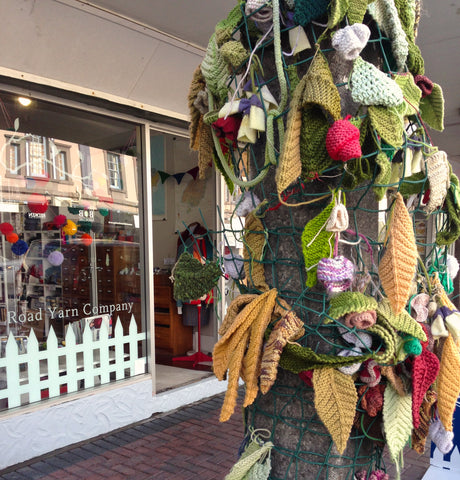
All you need to do is find some scrap yarn, make up a leaf or flower or several, and drop them in to us. Or post them, if you aren't nearby. We'll add them to the tree - as a little way to show how you help to make this little shop of ours special.
Below are our tried and true leaf and flower patterns - however feel free to make up your own or find one elsewhere.
It's a [simple and easy] Flower!
Cast on 40 stitches, leaving a 30cm tail
Knit for 8 - 10 rows
Bind off all stitches.
Using the bind off tail and tapestry needle, do a running stitch along the bottom edge, pulling tight as you go so the fabric gathers.
Pull it all together and make a few securing stitches so it holds. Stitch the free edge to the out side of the flower. Thread both tails through the needle, make a few stitches to carry both to the base of the flower. Leave these so we can attach it to the tree. Done!
It a Leaf!
Abbreviations
CO - Cast on
K - knit
P - Purl
M1 - Using left needle, pick up stitch between needles, knit into back of new stitch using right needle
SL2, K1, P2SSO - slip 2 stitches to right needle, knit 1, pass 2 slipped stitches over knit stitch
Cast On 10 stitches
Row 1: k10, CO 9
Row 2: k19
Row 3: k1, m1, k7, (sl2, k1, p2sso), k7, m1, k1
Row 4: p19
Row 5: p9, k1, p9
Row 6: k9, p1, k9
Row 7: k1, m1, k7, (sl2, k1, p2sso), k7, m1, k1
Repeat Rows 4 - 7 two times
Row 16: p19
Row 17: p9, k1, p9
Row 18: k9, p1, k9
Row 19: k8, (sl2, k1, p2sso), k8
Repeat rows 16 - 19, each time reducing K stitches on each side of decrease by 1.
When there are only 3 stitches left:
Row 41: k3tog
Cut yarn, pull through last stitch, and weave in end. Don’t weave in the cast on tail - we need this to attach it to our tree!
Drop your finished leaves and flowers into the shop anytime, or post them to:
Holland Road Yarn Company
281 Jackson Street
Petone 5012
Wellington
A delight of new colour
In all the excitement of last week, we didn't have the chance to share some scrummy new colours that we ordered in...
Blue Sky Alpaca Silk Alpaca in Crabapple and Papaya
Silk Alpaca is a gorgeous sport weight that is peeeeerfect for fingerless mitts. You can get a pair out of one skein, but with a range of colours that pair up so beautifully, this yarn is a dream match for the Dream Mitts.
Spud & Chloe Sweater in Firecracker, Splash and Grass Green
Spud & Chloe Sweater wants to be squished. Soft and plump and absolutely fantastic for knitting into baby blankets. Even better: it can be thrown in the machine. It can be tricky to get cotton mix yarns in NZ as we don't produce cotton, and Sweater is a glorious combo of cotton and wool so it's great in summer and winter.
Spud & Chloe Fine in Dolphin, Cricket, Goldfish, Popcorn and Sassafras
A clever mix of silk and wool, Spud & Chloe Fine is like any good sock yarn - durable enough to wear on your feet, but versatile enough to be made into absolutely anything. The new shades we got in are lovely soft Spring colours - a nice to way to brighten up cold winter days.
Adding new colourways to the ranges we stock is super exciting. Slowly but surely we're getting in every colour of every yarn base and it fills the shelves with joy. There's a simple but perfect pleasure in being in a shop filled with shelves where the yarn speaks for itself. If there's ever any colour of a yarn that we don't have in stock, just let us know! We're more than happy to order it in for you.
xx Tash
